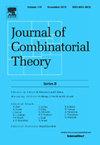关于距离正则图的自同构群
IF 1.2
1区 数学
Q1 MATHEMATICS
引用次数: 0
摘要
图的运动是图的满自同构群的最小度。Babai推测,对于某个通用常数C>;0,原始距离正则图在n个直径大于2的顶点上的运动至少为n/C,除非该图是Johnson或Hamming图。我们证明了一个直径d≥3的距离正则图在n个顶点上的运动至少为Cn/(log n)6,对于某个通用常数C>;0,除非它是Johnson, Hamming或crown图。为了证明这一点,我们改进了Kivva先前的一个结果,他给出了n/cd形式的运动下界,其中cd指数地依赖于d。作为一个推论,我们导出了一个原始距离正则图的自同构群大小的拟多项式上界,该图及其距离2图的边传递作用。证明使用初等组合论证,不依赖于有限单群的分类。本文章由计算机程序翻译,如有差异,请以英文原文为准。
On the automorphism group of a distance-regular graph
The motion of a graph is the minimal degree of its full automorphism group. Babai conjectured that the motion of a primitive distance-regular graph on n vertices of diameter greater than two is at least for some universal constant , unless the graph is a Johnson or Hamming graph. We prove that the motion of a distance-regular graph of diameter on n vertices is at least for some universal constant , unless it is a Johnson, Hamming or crown graph. To show this, we improve an earlier result by Kivva who gave a lower bound on motion of the form , where depends exponentially on d. As a corollary we derive a quasipolynomial upper bound for the size of the automorphism group of a primitive distance-regular graph acting edge-transitively on the graph and on its distance-2 graph. The proofs use elementary combinatorial arguments and do not depend on the classification of finite simple groups.
求助全文
通过发布文献求助,成功后即可免费获取论文全文。
去求助
来源期刊
CiteScore
2.70
自引率
14.30%
发文量
99
审稿时长
6-12 weeks
期刊介绍:
The Journal of Combinatorial Theory publishes original mathematical research dealing with theoretical and physical aspects of the study of finite and discrete structures in all branches of science. Series B is concerned primarily with graph theory and matroid theory and is a valuable tool for mathematicians and computer scientists.

 求助内容:
求助内容: 应助结果提醒方式:
应助结果提醒方式:


